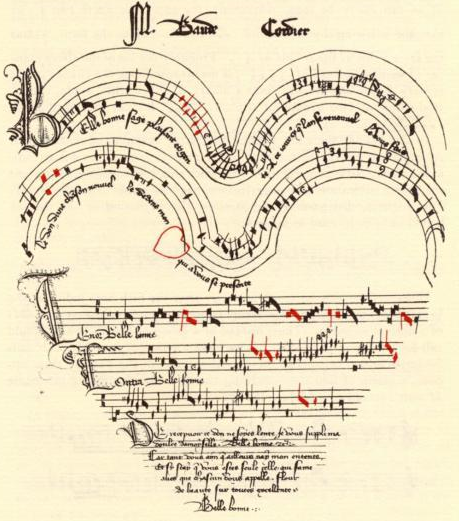
“Belle, Bonne, Sage.” Baude Cordier (1380-c. 1440)
MS Chantilly, Musée Condé 564; c. 1350-1400
Image source: Wikimedia Commons
HARMONY / MUSIC
- reading: Fair Welcome, perfect gardens, soundscapes, dance and mapping, lyricism (Roman de la Rose 3-26, 43-45, 50-61, 320-335)
TUESDAY
1 Discussion of blog questions and comments on week 9
—Soundtrack: Thomas Tallis, Spem in alium (40-part motet, c. 1570); The Taverner Choir.
2 A QUESTION TO CONSIDER:
The story of Pygmalion, its relationship to Genius & Nature on creativity, and what the difference is (insofar as there is one…) between:
—a stone-mason and a sculptor?
—a carpenter and a carver?
—a metal-worker or a smith and a jeweller (we can also discuss the interesting in-between-or-both case of goldsmith & silversmith)?
—“craft” and “art”?
—“science” (broad sense) & the “scientific” vs “technique,” “technical,” “technology”?
—in relation to astronomical instruments and the differences in their cultural significances?
—Soundtrack: Guillaume de Machaut, Messe de Notre Dame (c. 1360s); Ensemble Organum
3 Bringing together the liberal arts so far (see also: your online commentary, especially presentation notes, for weeks 4-9) and continuing your individual mappings of the Roman de la Rose: Art(s), psychogeography, and ideas of making and finding, materials and sense, and “making sense of” and understanding
Bonus soundtrack: Alessandro Striggio, Missa sopra ‘Ecco sì beato giorno’ (c. 1565); The BBC singers, Tallis Scholars, His Majesty’s Sagbutts & Cornetts, Davitt Moroney
THURSDAY
- student presentation & class discussion
- comparative gardens and fountains, perilous mirrors and crystals, and happy and other endings